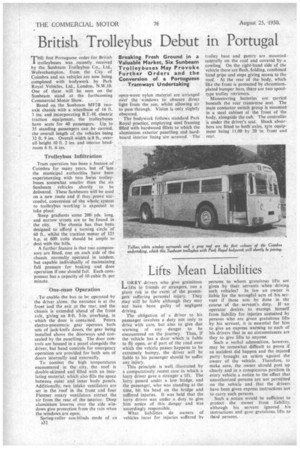British Trolleybus Debut in Portugal
Page 34

If you've noticed an error in this article please click here to report it so we can fix it.
Breaking Fresh Ground in a Valuable Market, Six Sunbeam Trolleybuses May Provoke Further Orders and the Conversion of a Portuguese Tramways Undertaking
THE first Portuguese order for British trolleybuses was recently received by the Sunbeam Trolleybus Co., Ltd., Wolverhampton, from the City • of Coimbra and six vehicles are now being completed with bodywork by Park Royal Vehicles, Ltd.. London. N.W.10. One of these will be seen on the Sunbeam stand at the forthcoming
Commercial Motor Show. • Based on the Sunbeam MF2B twoaxle chassis with a wheelbase of 16 ft. 3 ins, and incorporating B.T.-H. electric traction equipment, the trolleybuses have seats for 40 passengers. Up. to 35 standing passengers can be carried, the overall length of the vehicles being 32 ft. 9 ins. Overall width is 8 ft., overall height, 10 ft. 2 ins, and interior headroom 6 ft. 6 ins.
Trolleybus Infiltration
Tram operation has been a feature of Coimbra for many years, but of late the municipal authorities have been experimenting with two Swiss trolleybuses somewhat smaller than the six Sunbeam vehicles shortly to be delivered. These Sunbeams will be used on a new route and if they prove successful, conversion of the whole system to trolleybus working is expected to take place.
Steep gradients some 200 yds. long, and narrow streets are to be found in the city. The chassis has thus been designed to afford a turning circle of 60 ft.. whilst the traction motor of 125 h.p. at 600 volts should be ample to deal with the hills.
A further feature is that two compressors are fitted, one on each side of the chassis normally operated in tandem. but capable individually of maintaining full pressure for braking and door operation if one should fail. Each compressor has a capacity of 10 cubic ft. per minute.
One-man Operation
To enable the bus to be operated by the driver alone, the entrance is at the front and the exit at the rear, and the chassis is extended ahead of the front axle, giving an 8-ft. 3-in. overhang, in which the door is contained. Peters electro-pneumatic gear operates both sets of jack-knife doors, the gear being installed above the doorways and concealed by the panelling. The door controls are housed in a panel alongside the driver, but hand controls for emergency operation are provided for both sets of doors internally and externally.
To combat the high temperatures encountered in the city, the roof is double-skinned and filled with an insulating material, which also fills the space between outer and inner body panels. Additionally, two intake ventilators are set in the roof in the front and four Flettner rotary ventilators extract the air from the rear of the interior. Deep aluminium louvres over the side windows give protection from the rain when the windows are open.
Spring-roller sun-blinds made of an A32 open-wove nylon material are arranged °veilthe windows to obscure direct light 'from the sun, whilst allowing air to pass through. Vision is only slightly obscured.
• The bodywork follows standard Park Royal practice, employing steel framing filled with hardwood fillets to which the aluminium exterior panelling and hardboard interior lining are screwed. The trolley base and gantry are mounted centrally on the roof and covered by a cowling. On the right-hand side of the vehicle there are flush, folding, combined hand grips and steps giving access to the roof. At the rear of the body, which like the front is protected by chromiumplated bumper bars, there are two spooltype trolley retrievers.
Mameuvring batteries are carried beneath the rear transverse seat. The main contactor switch group is mounted in a steel cabinet at the front of the body, alongside the cab. The controller is under the driver's scat. Shock absorbers are fitted to both axles, tyre equipment being 11.00 by 20 in. front and rear.












































































